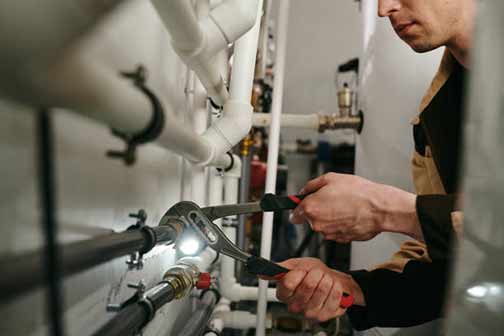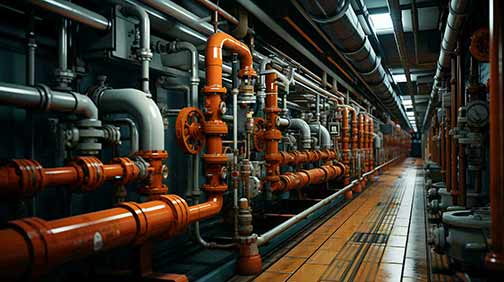Understanding Common Plumbing Challenges in Commercial Buildings
Commercial buildings often face unique plumbing challenges due to their size, the complexity of their systems, and the diverse needs of their occupants. Understanding these challenges is crucial for property managers, maintenance teams, and owners to ensure smooth operations and prevent costly disruptions. Below we get into the most common plumbing issues encountered in commercial settings, providing a foundation for identifying and addressing these problems effectively. The sheer scale of commercial plumbing systems means that any issue, no matter how small, can have a significant impact if not addressed promptly. From the water supply to waste management, each component must function seamlessly to avoid interruptions in daily business activities.
One of the fundamental challenges is the integration of various plumbing systems to cater to the diverse needs of commercial buildings. These buildings often house multiple types of facilities, such as kitchens, restrooms, and HVAC systems, each with specific plumbing requirements. As a result, the plumbing infrastructure must be robust and versatile enough to handle different demands simultaneously. Furthermore, the high volume of usage in commercial settings can accelerate wear and tear, necessitating more frequent maintenance and repairs compared to residential systems.
Identifying Leaks and Water Damage: A Proactive Approach
Leaks and water damage are among the most prevalent plumbing issues in commercial buildings. These problems can lead to significant structural damage, mold growth, and increased water bills if not addressed promptly. Identifying leaks early is key to minimizing their impact. Regular inspections and the use of advanced leak detection technology can help in spotting leaks before they escalate. This section explores various methods for detecting leaks and outlines steps to mitigate water damage effectively.
Leak detection technologies have advanced significantly, offering tools such as acoustic sensors, infrared thermography, and smart water meters, which provide real-time monitoring and alerts. These technologies allow for precise identification of leak locations, reducing the time and resources needed for repairs. Additionally, implementing a comprehensive water management plan can help in monitoring water usage patterns, thereby identifying anomalies that may indicate leaks. By adopting these proactive measures, building managers can address leaks before they cause severe damage, ensuring the integrity of the building’s structure and systems.
Addressing Clogged Drains and Sewer Lines Efficiently
Clogged drains and sewer lines can cause severe disruptions in commercial buildings, affecting everything from restrooms to kitchens. These clogs are often caused by the accumulation of debris, grease, and other materials. Promptly addressing these blockages is crucial to maintaining a hygienic and functional environment. In this section, we discuss the common causes of drain and sewer clogs and provide proven solutions for clearing them, including the use of hydro jetting and professional plumbing services.
To prevent clogs, it is essential to educate building occupants about proper waste disposal practices. Installing grease traps in kitchens and regular cleaning of these traps can significantly reduce the risk of clogs. Additionally, regular maintenance and cleaning of sewer lines using methods such as hydro jetting can help remove stubborn blockages and prevent future occurrences. Hydro jetting involves the use of high-pressure water streams to clear debris and buildup, ensuring the smooth operation of the plumbing system.
Managing Low Water Pressure Issues in Commercial Spaces
Low water pressure can be a frustrating issue in commercial buildings, impacting everything from daily operations to customer satisfaction. This problem is often caused by pipe corrosion, leaks, or issues with the municipal water supply. Identifying the root cause of low water pressure is essential for implementing effective solutions. Here, we explore the various factors that contribute to low water pressure and provide strategies for restoring optimal water flow throughout the building.
In addition to the common causes mentioned, low water pressure can also result from faulty pressure regulators or partially closed valves within the plumbing system. Conducting a thorough inspection of the entire system can help identify these issues. Once the cause is determined, appropriate measures such as replacing corroded pipes or adjusting pressure settings can be implemented to restore normal water pressure. Regular maintenance checks are vital to ensure that the system operates at optimal levels, preventing disruptions in water supply.
Preventing and Resolving Pipe Corrosion
Pipe corrosion is a common problem in older commercial buildings, leading to leaks, water discoloration, and reduced water quality. Preventing corrosion involves regular maintenance and the use of corrosion-resistant materials. In cases where corrosion has already occurred, timely intervention is necessary to replace or repair affected pipes. This section delves into the causes of pipe corrosion and offers practical solutions to prevent and address this issue, ensuring the longevity and reliability of plumbing systems.
Corrosion can be caused by various factors, including the chemical composition of the water, the presence of oxygen, and the type of materials used in the plumbing system. To mitigate corrosion, it is essential to use materials that are resistant to corrosion, such as PVC or PEX pipes. Additionally, implementing water treatment solutions, such as pH adjustment and the use of corrosion inhibitors, can help protect the plumbing system. Regular inspections and maintenance can also help detect early signs of corrosion, allowing for timely repairs and replacements.

Ensuring Proper Water Heater Maintenance and Functionality
Water heaters are essential components of commercial plumbing systems, providing hot water for various applications. Regular maintenance is crucial to ensure their efficiency and prevent breakdowns. Common issues with water heaters include sediment buildup, faulty thermostats, and leaks. Addressing these problems promptly can prevent costly repairs and downtime. This section provides a comprehensive guide to maintaining water heaters in commercial settings, including tips for troubleshooting common issues and scheduling regular inspections.
To maintain water heaters effectively, it is important to conduct regular inspections and flush the system to remove sediment buildup. Sediment can accumulate over time, reducing the efficiency of the heater and leading to potential damage. Checking and replacing faulty thermostats and heating elements can also help maintain optimal performance. Additionally, ensuring that the water heater is set to the appropriate temperature can prevent scalding and reduce energy consumption. Scheduling regular professional inspections can help identify potential issues before they become major problems, ensuring the reliable operation of the water heating system.
Implementing Preventive Plumbing Maintenance Strategies
Preventive maintenance is key to avoiding plumbing pitfalls in commercial buildings. By implementing a proactive approach, property managers can identify potential issues before they become major problems. Regular inspections, routine cleaning, and timely repairs are essential components of a successful maintenance strategy. This section outlines the benefits of preventive maintenance and offers practical tips for developing an effective plumbing maintenance plan tailored to the specific needs of commercial properties.
A comprehensive preventive maintenance plan should include regular inspections of all plumbing components, including pipes, fixtures, and water heaters. Routine cleaning of drains and sewer lines can prevent clogs and ensure smooth operation. Additionally, timely repairs of any identified issues can prevent them from escalating into more significant problems. Implementing a maintenance schedule and keeping detailed records of inspections and repairs can help property managers stay organized and ensure that all necessary tasks are completed on time.
Leveraging Technology for Smart Plumbing Solutions
Advancements in technology have revolutionized the plumbing industry, offering smart solutions for managing and maintaining commercial plumbing systems. From leak detection sensors to automated maintenance alerts, technology can significantly enhance the efficiency and reliability of plumbing infrastructure. In this section, we explore the latest innovations in plumbing technology and how they can be integrated into commercial buildings to improve performance and reduce the risk of plumbing issues.
Smart plumbing solutions include the use of IoT devices that provide real-time monitoring and control of plumbing systems. These devices can detect leaks, monitor water usage, and provide alerts for maintenance needs. Additionally, smart water meters can help track water consumption patterns, allowing for more efficient water management. By integrating these technologies into commercial buildings, property managers can improve the overall efficiency of plumbing systems, reduce water waste, and prevent costly repairs.
Collaborating with Commercial Plumbing Services for Optimal Results
While regular maintenance and proactive measures are essential, partnering with professional plumbing services can provide additional expertise and support. Experienced plumbers can offer valuable insights, conduct thorough inspections, and address complex plumbing issues that may arise. This section highlights the benefits of collaborating with commercial plumbers and provides tips for selecting the right service provider to ensure optimal results for commercial buildings.
When selecting a commercial plumbing service provider, it is important to consider their experience, reputation, and range of services offered. A reliable provider should have a track record of successfully handling commercial plumbing projects and offer a comprehensive range of services, including emergency repairs, regular maintenance, and system upgrades. Establishing a long-term partnership with a trusted commercial plumbing service can provide peace of mind, knowing that any plumbing issues will be addressed promptly and professionally.
Conclusion: Ensuring Reliable Plumbing Systems in Commercial Buildings
Maintaining reliable plumbing systems in commercial buildings is crucial for ensuring smooth operations and minimizing disruptions. By understanding common plumbing challenges, implementing preventive maintenance strategies, and leveraging technology, property managers can effectively address plumbing issues and enhance the longevity of their systems. Collaboration with professional plumbing services further ensures that complex problems are resolved efficiently, providing peace of mind for building owners and occupants alike.
In conclusion, a proactive approach to plumbing maintenance, combined with the use of advanced technologies and professional expertise, can significantly improve the reliability and efficiency of commercial plumbing systems. By prioritizing regular inspections, timely repairs, and smart solutions, property managers can create a safe and functional environment for all building occupants. This comprehensive strategy not only prevents costly disruptions but also contributes to the overall sustainability and success of commercial properties.


